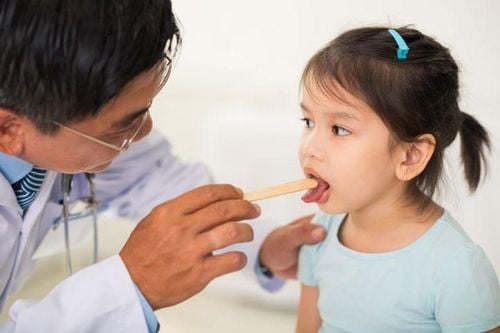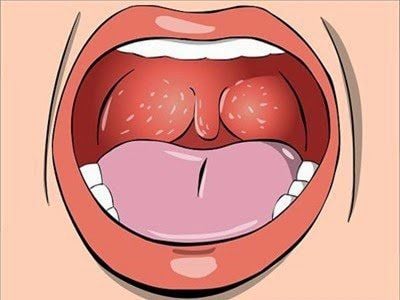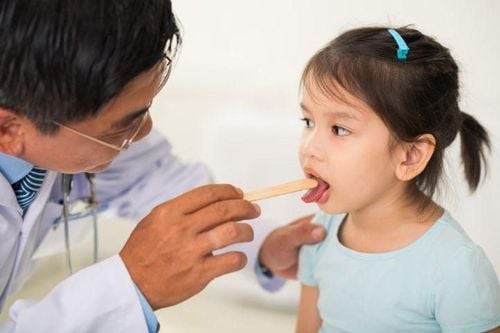This is an automatically translated article.
The article was consulted with Specialist Doctor II Nguyen Van Thai - Ear, Nose Throat Doctor - Department of Medical Examination & Internal Medicine - Vinmec Danang International General Hospital. He used to work at the Department of Otolaryngology - Hue Central Hospital with more than 17 years of treatment experience, especially in the field of Head and Neck Surgery.VA curettage and tonsillectomy are not too complicated procedures. With good care and recovery after VA curettage and tonsillectomy, children can recover completely without leaving any complications. Let's find out the article with Vinmec below.
1. The process of tonsillectomy and VA curettage in children
Vasectomy and tonsillectomy are usually sedated or local anesthetic, lasting from 30 - 60 minutes. The child was anesthetized through a mask, intubated, and carefully monitored throughout the surgery. The tonsils and VA are removed through the mouth so there won't be any incisions in the face or neck. After completion, the child wakes up from anesthesia, the endotracheal tube is removed and the child continues to be monitored in the postoperative room until the child is awake enough to move to the usual ward or can be discharged home. home.
When the child is released from the effect of the anesthetic, there may be different reactions such as crying, panicking, confusion, upset stomach or vomiting. These reactions are quite normal and will pass quickly when the anesthetic wears off completely. When the child is fully awake, parents can help the child to go to the toilet. Some children may vomit thick brown discharge if they swallow some blood during and after tonsillectomy and curettage, this is normal and parents can rest assured. However, if your child continues to vomit, call your doctor right away. Usually, the doctor will discharge the child from the hospital when the child can drink water and the general condition returns to normal (usually after 1-2 hours).
2. Child care after tonsillectomy and curettage
Vasectomy rarely causes much pain or difficulty swallowing. Children with varicose veins can go back to school after 1-3 days. Tonsillectomy is a larger surgery, so it can be more painful, it takes about 2 weeks for the body to fully recover and return to normal.
2.1 The first days after tonsillectomy and curettage
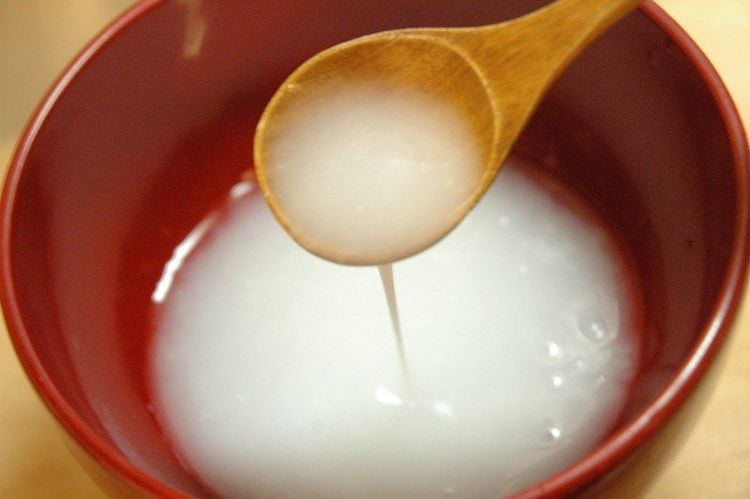
Cha mẹ nên cho trẻ ăn thức ăn lỏng sau khi cắt amidan
Children who have just had a curettage or tonsillectomy may be a little dizzy for the first day after anesthesia and have nausea or vomiting. Parents, let your child drink clear liquids or eat liquid foods. Give plenty of water to drink to prevent dehydration, which often happens after surgery, and dehydration is dangerous and increases the child's pain. After the child drinks liquids and no longer vomits, parents can now switch to solid foods and slowly return to a normal diet.
2.2 The healing process after tonsillectomy and curettage
Usually, healing takes place within 10 days after the procedure, sometimes it can take longer due to infection. The location of the tonsils removed will be very strange for the first 7-10 days, the wound surface will look very dark. After a few days, the spot will turn yellow or brown. After 2 weeks, the covering scab will fall off on its own. This is the time when the child's diet can be restored to the way it was before.
Children performing VA curettage will not have pain when swallowing food, whereas children with tonsillectomy will have pain in the throat or pain when swallowing. Parents should encourage children to take frequent sips of water, even though this can be painful for the child. The feeling of discomfort or pain in the throat will occur for the first few days, the most painful around the 5th day after tonsillectomy, the saliva may be mixed with a little blood. After that, the discomfort will gradually decrease and may increase again on the 7th - 9th day after surgery, because a part of the scab covering the tonsillectomy site gradually peels off. After all, the child's pain will be significantly reduced.

Cảm giác đau họng ở trẻ sẽ diễn ra trong vài ngày đầu
2.3 Measures to relieve pain
Children with varicose veins often feel pain or stiffness in the neck due to the lying position during surgery, this pain usually goes away after a few days. Parents can apply warm compresses, use pain relievers and instruct children to do some gentle neck rotation exercises that can help improve neck stiffness.
Children drooling, complaining of pain in the mouth, feeling pain or discomfort in the ear area... these are normal after surgery, usually the pain is diffused from the healing area of the throat, not Symptoms of an ear infection. You can let your child chew gum or eat foods that must be chewed thoroughly before swallowing to help reduce this pain.
Use paracetamol preparations as indicated. Note that the medicine should not be given to the child on an empty stomach because it may increase the risk of vomiting after surgery. Do not use Ibuprofen within the first 2 weeks after surgery because this medicine will increase the risk of bleeding. Parents need to make the child drink a lot of water, distract the child with games or other activities whenever the child complains of pain. During the first 2 weeks after tonsillectomy, avoid giving your child hard foods that can scratch the surgical area such as: biscuits, toast, pizza, chips..., milk and dairy products can increase stagnation in the ENT area.
2.4 Children with fever after tonsillectomy and curettage
Children may have a mild or moderate fever below 38.5 degrees Celsius and will go away on their own. In case the child has a clear watery nose, not a yellow nose and eats normally, there is no cause for concern. Mild fever can be caused by mild dehydration or the healing process in the throat area.
Trẻ có thể sốt nhẹ sau khi cắt amidan và nạo VA
2.5 Baby's breath smells
A child's breath can have a very unpleasant odor, which is common after surgery and can last for several weeks. This is the result of the wound healing process at the surgical site, the throat secretes a lot of phlegm, the child is reluctant to swallow, leading to a lot of secretions, which is not unusual and not worrisome.
Parents need to keep the child's oral hygiene properly, use physiological saline to clean the nose or let the child chew gum, suck on hard candy to help improve the situation. Drinking plenty of water can also help ease bad breath symptoms. Liquid and cool drinks are often favored by children, avoid acidic drinks (orange juice, lemon juice) because they cause pain and make breath worse.
2.6 Bleeding after tonsillectomy and curettage
Bleeding is rare but can still occur after tonsillectomy and VA curettage (3% of children with tonsillectomy will have it). In most cases, bleeding is minimal, but occasionally serious or life-threatening complications can occur at any time within the first 14 days.
The risk is highest in the first hours after surgery and between the 4th and 8th day after surgery. During the 4th - 8th day, parents can see a white or pale yellow scab in the area of the tonsil that has been cut, when it comes off, it may cause some bleeding, the child also feels discomfort in this area.
Bleeding is usually insignificant and will usually stop on its own, if the bleeding is heavy or the bleeding does not stop on its own, parents need to quickly take the child to the nearest medical facility.
2.7 Dental care after tonsillectomy and curettage
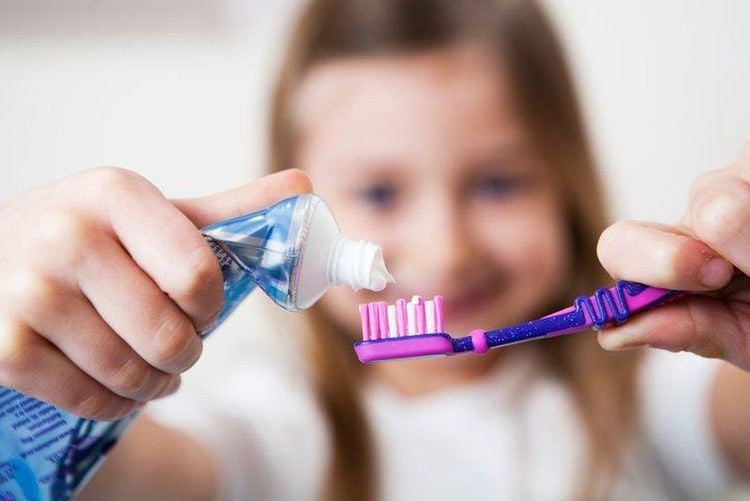
Trẻ cần chăm sóc răng miệng cẩn thận sau khi cắt amidan
2.8 Daily activities after tonsillectomy and curettage
You can shower normally and rest completely for the first few days after surgery, then gradually increase physical activities. Avoid vigorous activity for the first 2 weeks after surgery because the baby may have slight bleeding through the nose if vigorous activity is too early. During this time, children are prone to colds or infections, it is necessary to isolate them from sick people in the family and limit visitors. Avoid going to crowded places to prevent infection.
3. In case you need to contact a doctor
Usually, after discharge, the child does not need to be examined again. However, there are some cases where parents should take their children to see a doctor:
Fever above 39 degrees Celsius, not reduced when taking Paracetamol. Nausea or vomiting a lot. Severe pain that does not respond to treatment within 48 to 72 hours. Can't drink water, stop eating completely. Severe bleeding (blood may come from the mouth or nose or even vomit blood). The child lost his voice for 24 hours.

Bệnh viện Đa khoa Quốc tế Vinmec Đà Nẵng cung cấp dịch vụ cắt amidan, nạo VA
Nutrition plays an important role in helping children recover well after tonsillectomy and VA curettage. Parents should supplement their children with supporting products containing lysine, essential micro-minerals and vitamins such as zinc, chromium, selenium, and B vitamins to help fully meet the nutritional needs of children. At the same time, these essential vitamins also support digestion, enhance nutrient absorption, help improve anorexia, and help children eat well.
Parents can learn more:
Signs of zinc deficiency in children
Micronutrient deficiency and failure to gain weight in children
Please regularly visit Vinmec.com website and update useful information to take care of your child. Take care of the baby and the whole family.





